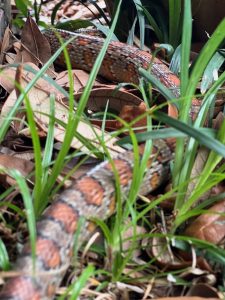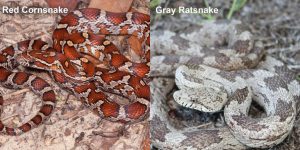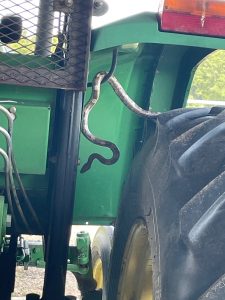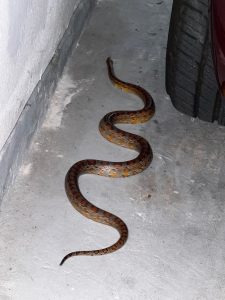
It’s warm here in northwest Florida, which means our cold-blooded reptile friends are on the move. In the last few weeks, I’ve seen a snake at work, one at home, and received snake photos from my neighbors’ and parents’ yards. A fear of snakes seems to be both innate and passed down from one generation to the next. Cryptic by nature, snakes often surprise us when they appear in our path. Their lack of arms and legs feels creepy to us four-limbed mammals, and when you add in the fact that some of them are venomous, it’s a recipe for conflict. If I had a quarter for every time somebody told me, “the only good snake is a dead snake,” I could retire tomorrow.
So, I’m here to make the case for keeping good snakes alive. If you have spent any time around my colleague Rick O’Connor, you know he’s forever picking them up and singing their praises. It’s unlikely that you’ll catch me picking a snake up, but I’m definitely a fan of these fascinating creatures.

Half the battle towards conquering a fear of snakes is knowing what you’re looking at. If you can recognize some of the most common nonvenomous snakes and realize which one is in your yard, it’ll take the edge off that first shot of adrenaline. The ones I hear of and see most frequently are garter snakes, black racers, and rat snakes. Rat snakes often have diamond patterned skin, but with practice it is easy to differentiate them from anything with venom. The Florida Museum of Natural History website has a really well done web-based snake identification guide categorized by pattern and using excellent photos.

Members of the genus Pantherophis are more commonly known as the gray rat snake, (Pantherophis spiloides), red rat snake, aka corn snake (P. guttatus) and the Eastern or yellow rat snake (P. alleghaniensis). We see few Eastern rat snakes in the western Panhandle, but they often interbreed with the gray and red varieties. Full grown, ray rat snakes can grow to be anywhere from 3 to 7 feet long, whereas red rat snakes are usually no more than 4 feet.
Rat snakes are docile, with eye-catching color patterns. I recently came across a gray rat snake curled around a tractor tire at the 4-H property in Barrineau Park. Six of us were standing around within a few feet of it, but the snake ignored us, slowly winding its way around the equipment. At midday, it was resting in the shade and conserving energy. My kids and parents also had an interaction with a rat snake recently. As my son walked through his grandparents’ garage, he stepped on something “squishy” that felt like a hose or rope. To his surprise, it was a large red corn snake, lying right at the threshold of their door. Even after being stepped on, it was alert but not aggressive, slowly finding an escape route into the yard. Snakes generally avoid conflict when given the chance to leave on their own.

As their name implies, rat snakes are known for feeding on rats and mice. They perform an important community service, if you will, keeping the population of vermin in check. They also eat insects, frogs, and birds. Rat snakes are constrictors, but will eat smaller prey whole and alive.
Snakes play an important role in the ecosystem, serving as both predator and prey for many animals. They are in the business of hiding most of the time, and would rather not see people. If you do have a lot of unwanted snake interactions on your property, there are several things you can do to reduce their likelihood, like sealing gaps in buildings where snakes can hide and keeping brush piles well away from a home. But the easiest thing is to observe them from a distance and let them go about their day. While any wild animal will bite in self-defense, the odds of being bitten very low if you don’t harass or try to pick one up!
 10
10
